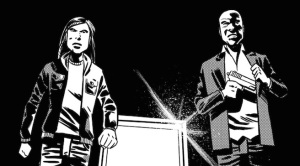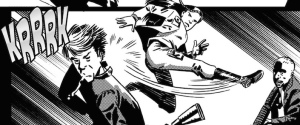[Standard Disclaimer: This review is based on an Advanced Reader Copy PDF that was provided by the creator Kelci D. Crawford.]
[Nonstandard Disclaimer: Kelci is an online buddy and a collaborator on a project that we hope to realize together someday. This will of course bias my opinion, but no reviewer is entirely free of bias; and you are probably aware that I focus on positive impressions on this blog anyway.]
Introduction
Thoughtful Dinosaur is a comic created by Kelci D. Crawford. It is not a webcomic, but it was available for free to newsletter subscribers and Patreon supporters. With a successful Kickstarter it will become a self-puplished book. See her blog for details, and for her many other comics.
Thoughtful Dinosaur is one of these smaller comics that are not particularly ambitious in scope, but are extraordinarily fun to read. Kelci has done many of these before (my favorite is Charlie & Clow), as well as an ongoing comic (Validation, with Christian Beranek), and her experience is clearly noticeable in the quality of Thoughtful Dinosaur.
Setting & Worldbulding
The setting is Fantasyville, already known from Kelci’s webcomic Johnson And Sir. This reuse of a ready-made setting allows both the creator and the – knowledgeable – reader to focus on the main character and her live, rather than spending time to explore an unknown setting first. (But don’t worry, if you haven’t read Johnson And Sir, you will get into the story quick enough.)
It looks ike the typical – whatever that means – small American town, except it’s populated by fantasy people, and anthropomorphic animals, living or extinct. This makes for an environment that feels very familiar, but also fresh and interesting.
Plot
[SPOILERS for the first half of the story -BEWARE!
The plot is simple and straightforward, but very well structured. The story begins with the titular hero, Thoughtful Dinosaur Billy Veloci, graduating college, getting her first job, and getting fired. All on the first page, this is just right to set up the story.
Billy has to move back in with her mother, starts looking for jobs, works some unsatisfactory ones, and checks in with old friends. One friend suggests she write a blog, and after short deliberation, she does so, becoming the Thoughtful Dinosaur. This happens on pages 7 and 8, right in the middle, providing an excellent midpoint where the story changes direction.
The second half of the story shows how Billy gets traction on her life, starting to earn money and have fun, barely enough of the former, but all the more of the latter, and ends with her having overcome the crisis and gained a positive outlook on life and the future.
[No More Spoilers Below]
Narration & Dialog
The narration and the dialog are equally fun, colorful, naturally flowing, and never pretentious or overwritten. They are very well-integrated with the visual storytelling, and provide the reader with wonderful insight into the thoughts and feelings of Billy Veloci.
The dialog reflects remarkably distinct character voices, which are totally consistent with the behavior and the outward appearance of the characters.
Apart from one instance each, neither narration nor dialog are typically specific to the species involved; without visuals, they would mostly read as human. But this is by design and not a flaw.
Art & Visual Storytelling
The visual style of Thoughtful Dinosaur is pure Kelci D. Crawford:
The backgrounds economical rather than lush, but with remarkably details wherever she puts her focus on; the characters varying in shape and look, way more than what’s necessary because of species differences; most of the characters look quite attractive, but nobody is just eye-candy; body language and facial expression are spot on.
The page layout is clear and effective, it always keeps the reader oriented, and guides the reader’s attention, and helps the reader follow the story. It also demonstrates Kelci’s great ability to render scenes without physical movement or action, e.g. two people talking, or just one person thinking or writing, in a very dynamic way that infuses them with motion, emotion, and occasionally commotion.
Anthropomorphic Non-human Characters
The characters are pretty cool: They are somewhat stereotypical for their roles, but have their nice quirks as well, and the characterization is full of life.
They speak and behave like humans, but they look their part as fantasy or animal folks. Kelci uses her own variation of the animal-head-and-upper-torso-but-human-hands-and-legs technique that we all know and love from BoJack Horseman or Zootopia. In her style, she keeps the upper torso human for most people, which among other things allows her to draw some of the female characters with a shape that is very sexy in a realistic way.
It is great how using this style Kelci conveys the full range of human facial expressions without compromising the animal shape: E. g. the predator dinosaurs have long faces with lots of teeth, but they can smile and laugh, and be pensive, worried, or angry, just like human beings.
If you’d argue that the fantasy is kind of a gimmick, in the sense that the story could happen just as well with human characters, I won’t deny it, but it is done with so much charm and expressiveness that I don’t mind at all, and neither should you.
Recommendation
Thoughtful Dinosaur is a fine little story, written with charm and drawn with atmosphere, and well worth reading, and, if and as long as it’s possible, supporting.
Coda: Comics & Short Stories
I would like to invent the term Graphic Short Story to describe comics like this. To elaborate: You may be aware of the discussion about the term Graphic Novel and the desire to see the term abolished. In my opinion its use as a badge of merit, in contrast to mere comics, is indeed superfluous and detrimental. Comics are fine comics are art, comics are literature, comics are a proper medium, comics are culture. The only use I’d ever make of the term Graphic Novel is to describe a comic that resembles a prose novel in scope, structure, and storytelling technique.
And in the same sense, Thoughtful Dinosaur is a Graphic Short Story, because it resembles a prose short story in a couple of ways: Limited scope, strong focus on a core idea, straightforward execution of a simple plot, an open end that makes the reader ask more questions instead of providing all the answers, and an excellent and beautiful, somewhat poetic presentation of the story details (words and sentences in prose, art and dialog in comics).
For the record: My favorite prose short story example is A Day’s Wait by Hemingway: The simple story of a boy who thinks he is going to die, because he is not aware that the doctor measured his fever in Fahrenheit and not in degrees Celsius, beautifully told so it tugs our heartstrings.

